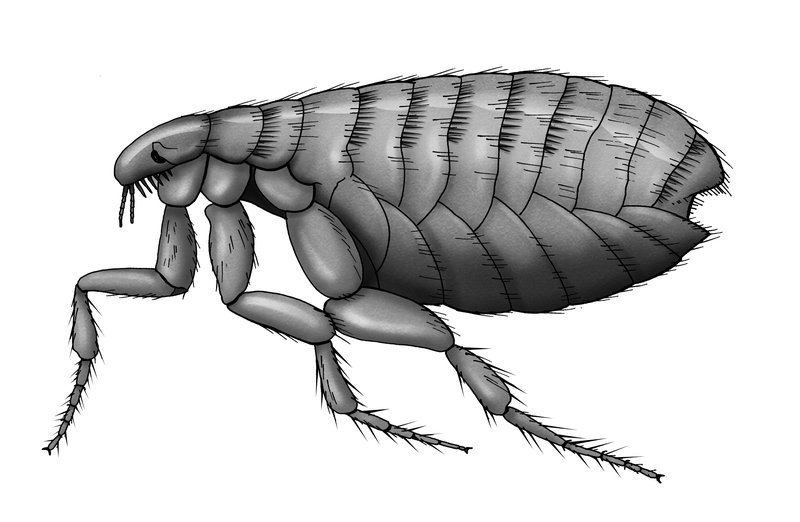What Do Fleas Look Like
In the battle against pesky fleas, understanding their appearance is your first line of defense. These minuscule creatures, notorious for causing discomfort to both humans and pets alike, have a long history of inflicting frustration upon households. Demystifying what fleas look like serves as a cornerstone for effective prevention and control. This comprehensive guide delves deep into the world of fleas, dissecting their physical attributes, behaviors, and unmistakable signs of infestation. Armed with knowledge about the appearance of fleas, you’ll be empowered to safeguard your home and cherished companions.

Identifying Fleas by Appearance:
Understanding Flea Anatomy:
Cracking the Code of Flea Structure
In the world of these minuscule adversaries, their intricate anatomy holds the key to their survival. Fleas may measure a mere 2-3 mm in length, but their flattened body design is an evolutionary marvel that allows them to expertly navigate through fur and feathers. Armed with six legs finely tuned for incredible jumping prowess, fleas can launch themselves onto hosts with astonishing precision. Their coloration, ranging from reddish-brown to nearly black, enables them to blend seamlessly into their surroundings, making them a challenge to detect.
Flea Life Stages and Appearance:
Metamorphosis Unveiled
Embarking on a journey of metamorphosis, fleas undergo a four-stage transformation: egg, larva, pupa, and adult. Each stage brings distinct changes in appearance, a crucial factor for accurate identification. Flea eggs, resembling tiny pearls, are typically laid on hosts or within their habitats. The larval stage, reminiscent of tiny worm-like creatures, thrives in dark, humid settings, feeding on organic debris. Pupae encase themselves in protective cocoons, culminating in the emergence of adult fleas. These adults showcase the iconic flattened body, robust legs, and a dark exoskeleton.
Visual Characteristics of Fleas:
Decoding Flea Features
Upon close observation, adult fleas reveal a multitude of intriguing traits. Their flattened body facilitates easy movement through hair, while their elongated legs are marvels of engineering, facilitating their impressive jumping abilities. Fleas possess specialized mouthparts adept at piercing hosts’ skin for blood extraction. After feeding, their abdomens expand, altering their appearance—providing a telltale sign of their feeding activity. Their dark exoskeleton serves as effective camouflage, aiding their ability to conceal themselves within pet fur, bedding, and carpets.
Flea Characteristics and Behavior:
Behavioral Patterns of Fleas:
Leap into Understanding Flea Behavior
Fleas, despite their diminutive size, boast remarkable behaviors that contribute to their survival and infestation strategies. One of their most astonishing abilities is their adeptness at jumping. Equipped with powerful legs, fleas can leap up to 150 times their own body length. This enables them to effortlessly navigate from host to host or from environment to host. Their agility and swift movement make them elusive targets, underscoring the importance of comprehending their appearance for accurate identification.
Flea Habitat and Behavior:
Unveiling Flea Haunts and Habits
To truly comprehend what fleas look like, it’s essential to delve into their preferred habitats and behaviors. Fleas thrive in environments that provide suitable conditions for their development, often favoring warm and humid settings. Common hideouts include pet bedding, carpets, rugs, and cracks in flooring. Understanding their habitat preferences is integral to recognizing potential infestation sites. Their propensity to conceal themselves in these areas makes visual identification challenging, emphasizing the need to know their appearance cues.
Flea Infestation Signs and Symptoms:
Recognizing Flea Bites on Humans and Pets:
Itchy Truths about Flea Bites
Flea bites are notorious for causing discomfort and irritation. Identifying the appearance of flea bites is a crucial step in determining infestations. In humans, flea bites typically manifest as small red bumps, often surrounded by a halo of redness. They may be grouped in clusters or lines, indicating multiple bites. On pets, bites can lead to excessive scratching, redness, and hair loss. Understanding these symptoms helps differentiate flea bites from other skin irritations, contributing to timely intervention.
Pet Scratching and Allergic Reactions:
Unmasking Flea-Induced Allergies
One key indicator of flea presence is excessive scratching in pets. Flea saliva can trigger allergic reactions in some animals, intensifying itchiness and discomfort. Pets experiencing flea allergy dermatitis (FAD) may exhibit symptoms such as persistent scratching, chewing, and grooming. Over time, FAD can lead to hair loss and skin infections. Recognizing these symptoms and their link to fleas is essential for accurate diagnosis and effective management.
Differentiating Fleas from Similar Pests:
Fleas vs. Bed Bugs: Appearance and Symptoms:
Deciphering the Flea vs. Bed Bug Puzzle
In the quest to recognize what fleas look like, it’s essential to differentiate them from other pests, such as bed bugs. Both fleas and bed bugs can provoke discomfort, but their appearance and behaviors vary significantly. Fleas, with their flattened bodies and powerful jumping capabilities, are adept at navigating through fur and feathers. Bed bugs, on the other hand, are reddish-brown, oval-shaped insects that lack wings and jump. While both pests leave behind itchy bites, understanding these distinctions can aid in accurate identification and targeted treatment.
Fleas vs. Ticks: Distinguishing Features:
Unmasking Fleas and Ticks: Telltale Signs
Fleas and ticks share similarities in their parasitic nature, yet they possess distinct features that set them apart. Fleas are known for their swift movement and jumping prowess, while ticks are slower and often remain attached to hosts for extended periods. Ticks have a rounder, more compact body and vary in size based on their life stage. Fleas, as previously explored, have a flattened profile and are typically smaller. Being able to distinguish these differences enhances your ability to identify and address infestations accurately.
Preventing and Managing Flea Infestations:
Effective Flea Prevention Strategies:
Fortifying Your Defense Against Fleas
Preventing flea infestations is a proactive approach that begins with understanding their appearance and behavior. Regularly grooming and inspecting your pets is essential. Keep living areas clean by vacuuming regularly and washing pet bedding in hot water. Consider using flea preventative treatments recommended by your veterinarian. Outdoor spaces should also be maintained, as fleas can thrive in yards and gardens. By comprehending the visual cues of fleas and their habits, you can implement a comprehensive prevention plan.
Treating Flea Infestations:
Taking Action Against Fleas
Should an infestation occur, swift action is imperative. Start by treating your pets with vet-approved flea treatments to eliminate existing fleas and prevent reinfestation. Thoroughly clean your home, focusing on areas where pets spend time. Vacuuming, washing linens, and using insecticides can help eradicate fleas and their eggs. In severe cases, professional pest control services may be necessary. Understanding what fleas look like empowers you to take effective steps towards eradicating infestations and restoring comfort to your home.
Frequently Asked Questions (FAQs) About Fleas
1. What do fleas look like to the naked eye?
Fleas appear as tiny, dark, reddish-brown to black insects with flattened bodies and six legs. They measure around 2-3 mm in length.
2. How can I distinguish flea bites from other insect bites?
Flea bites are often small, red, itchy bumps with a central puncture mark. They may appear in clusters or lines on the skin.
3. Do fleas only affect pets?
No, fleas can bite both pets and humans. While pets are common hosts, fleas can also bite and infest people.
4. Are fleas dangerous to humans?
While fleas themselves are not typically dangerous, their bites can cause itching, discomfort, and allergic reactions in some individuals.
5. How fast do fleas reproduce?
Fleas have a rapid reproductive cycle. A single female flea can lay hundreds of eggs in a short period, leading to infestations if not controlled.
6. Can fleas survive in cold weather?
Fleas prefer warm and humid conditions, but some species can survive in cooler temperatures. They tend to thrive indoors during colder months.
7. How do I prevent fleas in my home?
Regularly groom and treat your pets with veterinarian-approved flea products. Vacuum and clean your home frequently, especially pet areas.
8. Can I use natural remedies to get rid of fleas?
While some natural remedies like essential oils or diatomaceous earth may help, they might not provide complete elimination. Consult a professional for severe infestations.
9. Can fleas transmit diseases to pets and humans?
Fleas can transmit diseases such as tapeworms, Bartonella (cat-scratch disease), and murine typhus. However, disease transmission is relatively rare.
10. When should I seek professional pest control for fleas?
If your efforts to control fleas at home are ineffective or if the infestation is severe, it’s recommended to consult a professional pest control service for thorough eradication.
Conclusion
The ability to discern what fleas look like is a vital skill in the ongoing battle against these tiny yet troublesome pests. Armed with insights into their appearance, behaviors, and infestation signs, you’re better equipped to protect your family, pets, and living spaces. By leveraging this knowledge, you can proactively prevent infestations, swiftly address any outbreaks, and maintain a flea-free environment. Stay vigilant, prioritize prevention, and let your newfound understanding of flea appearances guide you towards a pest-free future.




